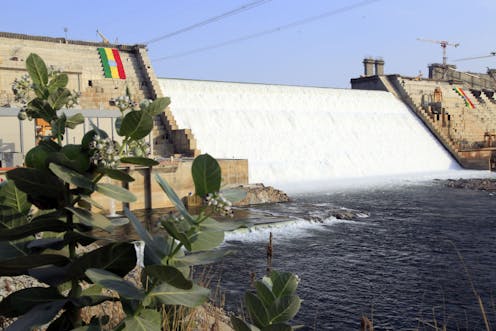
The US has revived diplomatic efforts to resolve the dispute sparked by Ethiopia’s Grand Ethiopian Renaissance Dam (GERD) project on the Nile. Sudan and Egypt, which rely most heavily on the Nile’s water flow, consider the US$4.6 billion reservoir as a serious threat to vital water supplies. But Ethiopia considers it essential for its electrification and development.
Egypt and Sudan opposed the construction of the dam from the start. But the project went ahead and was commissioned on 20 February 2022. Five articles from our archives trace the genesis and build-up of the conflict over Nile waters, and potential avenues for resolution.
The imperialist past
Britain occupied Egypt in 1882 and maintained a strong influence until 1956. Its textile industries depended on Egyptian cotton, which relied on irrigation using the River Nile’s water. British hydrologists developed a plan to regulate the flow of the Nile by building dams and reservoirs in downstream countries.
But the plan had one major flaw. It didn’t consider the interests of nine upstream countries, including Ethiopia, Kenya, Tanzania and Uganda.
Leer más: The imperialist past that started dam politics between Egypt, Sudan and Ethiopia
Egypt and Sudan want their “historically acquired rights” to be the baseline for all negotiations about the dam. But Ethiopia considers that unreasonable, and not in line with the principles adopted by all three countries in 2015.
The last round of talks, in 2018, failed.
Egypt has blamed Ethiopia for the stalemate. But many scholars cite colonial-era treaties as the reason for the impasse.
Leer más: Nile basin at a turning point as Ethiopian dam starts operations
From conflict to cooperation
Some have speculated that the dispute could degenerate into a “water war”. There is no doubt that the dam has become a source of serious tension for Egypt, Ethiopia and Sudan. But, in fact, the dam has also helped to shift longstanding power relationships and could pave the way for more cooperation among all the countries that depend on the Nile.
To date no country has fought a war over water resources. There is no reason why this case should be different.
Leer más: How the Grand Renaissance Dam might spark basin-wide water cooperation
Without data such as storage plans, it’s difficult for the countries involved in the dispute to know what effect the dam will have on their water security. Having this data and sharing it would be a game changer.
There is an opportunity to integrate scientific research into the ongoing negotiations.
Leer más: How to turn confrontation about Africa's biggest hydropower dam to cooperation
Solar and wind
The GERD’s reservoir will be large enough to store the full annual Blue Nile flow. But should anyone be allowed to exert such control over the Nile?
A win-win situation can be found for GERD’s long-term operation. If Ethiopia, Sudan, Egypt and their neighbours were to deploy large-scale solar and wind farms and establish a regionally integrated power grid, and if Ethiopia agreed to operate GERD in synergy with solar and wind power, the long-term benefits of this huge investment would outweigh the costs.
Leer más: Solar and wind power could break the Grand Ethiopian Renaissance Dam deadlock
This article was originally published on The Conversation. Read the original article.







